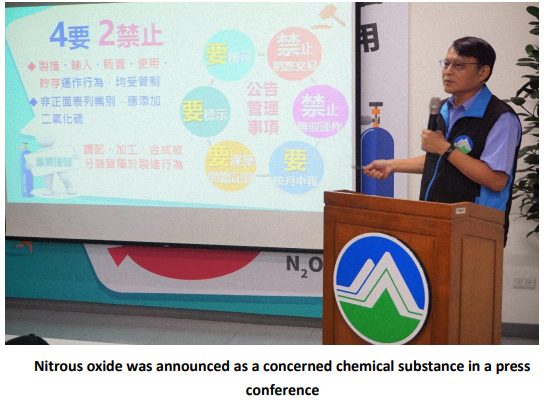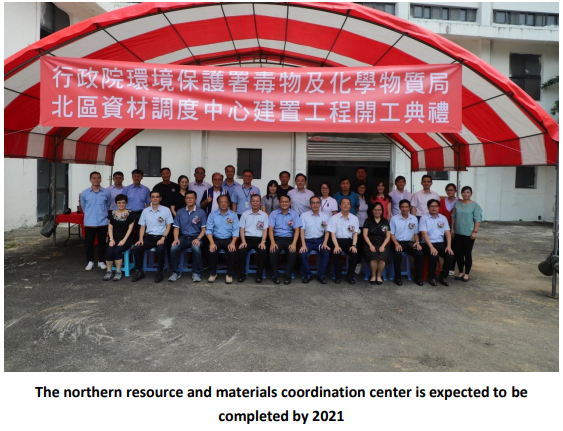- Date:2020-12-20
- Department:Chemicals Administration Ministry of Environment
To build a safe chemical environment, the EPA has announced nitrous oxide as a concerned chemical substance, and will continue to focus its efforts on integrating documents for toxic chemical substance management, promoting collaboration among industries, government agencies, and academia on chemical substance information registration, evaluating and listing toxic and concerned chemical substances, strengthening interdepartmental government response capabilities, and enhancing training capacities for toxic chemical substance disaster prevention and response. All of the above will be carried out in stages with corresponding indicators and targets set up every year.
Background
In light of the disastrous fire that broke out at Jing Pung Factory in Taoyuan City on 28 April 2018, the EPA formulated Building a Safe Chemical Environment Initiative (2020-2023) based on the vision stated in the National Chemical Substances Management Policy Guidelines”. The initiative was approved by the Executive Yuan on 17 May 2019.
Recent achievements
In response to the newly stipulated controls in the UN’s Stockholm Convention on Persistent Organic Pollutants, the EPA announced dicofol as a Class 1 and Class toxic chemical substance on 8 September 2020, and has tightened the control concentrations, bans and limits of several currently listed substances, including perfluorooctanoic acid (PFOA), perfluorooctane sulfonyl fluoride (PFOSA), perfluorooctane sulfonic acid (PFOS), lithium perfluorooctane sulfonate, and polybrominated diphenyl ethers (PBDEs), to keep up with the global pace and strengthen toxic chemical substance management in Taiwan.
In accordance with the Toxic and Concerned Chemical Substances Control Act (毒性 及關注化學物質管理法), which authorizes the formulation of regulations concerning listing concerned chemical substances for control, the EPA preannounced on 21 July 2020 that nitrous oxide was to be listed as a first concerned chemical substance, and officially announced the listing on 30 October. Thereafter, the EPA joined hands with the Ministry of Economic Affairs (MOEA), the Ministry of Health and Welfare (MOHW), and the police authorities to carry out controls, requiring enterprises to acquire permits and also register handling information for production, import, sale, use, and storage of nitrous oxide. Buying and selling nitrous oxide online is also prohibited to enhance the control and deter the improper use or consumption of the substance.
In accordance with the revised Permit Registration and Approval Regulations for Toxic and Concerned Chemical Substances (毒性及關注化學物質許可登記核可管理辦法) announced on 15 January 2020, the EPA adjusted the way permits and registration documents are issued. Enterprises were previously required to obtain permits separately for handling every single chemical substance, but after the revision, they can handle multiple substances with just one permit. This has saved enterprises the trouble of repeatedly submitting basic information of their handling staff and sites for reviews, and having permits with different validity periods and paying multiple fees for the permits. The revision has substantially reduced handlers’ administrative burden from permit application and streamlined local environmental authorities’ review procedures.
Document integration began on 1 May 2020. By the end of December 2020, 4,176 enterprises (99.7% of all 4,224 currently listed for control) had completed the renewal of their permits (with 26,388 permits integrated into 4,827 permits). In response to the newly implemented Standard Registration for Existing Chemical Substance, the EPA has designated 106 chemical substances that are widely circulated in Taiwan, have higher potentials to cause harms, and whose information is lacking, and required enterprises that manufacture or import over a metric ton of these substances to submit standard registration information within two or three years.
A Help Desk was set up by the EPA in October 2019 to assist individual enterprises. By the end of December 2020, the Desk had conducted three online and eight inperson explanatory meetings, and assisted 107 enterprises and six relevant organizations. Four of the enterprises have already submitted the standard registration information.
Key areas
1. Continuing to assess and list toxic and concerned chemical substances and strengthen their circulation control.
The EPA announced nitrous oxide as a first concerned chemical substance at the end of October 2020, and will continue to carry out joint inspections with Industrial Development Bureau (IDB) and Bureau of Foreign Trade (BFT) of MOEA, Food and Drug Administration (FDA) of MOHW, National Police Agency of Ministry of the Interior, Customs Administration (CA) of the Ministry of Finance (MOF), the Occupational Safety and Health Administration (OSHA) of Ministry of Labor (MOL), and local governments to stop improper use of nitrous oxide. Listing of hydrogen fluoride (HF) as a hazardous concerned chemical substance is also underway to tighten the source management and circulation control.
Aside from the two concerned chemical substances above, the EPA will keep evaluating whether to list for control the following: Substances that pose risks to food safety; narcotic precursor substances; explosive precursor substances; substances that pose higher risks to human health or the environment; substances that are listed as highly concerned or controlled substances by the EU, other countries, or international conventions.
The EPA expects to complete preliminary investigation on more than 1,000 chemical substances with respect to their physical and chemical characteristics, uses, exposure routes, current handling status in Taiwan, and control status in other countries or in international conventions by the end of 2021. The EPA will then gradually implement the follow-up announcements and listings for control.
2. Integrating documents for handling toxic chemical substances to simplify application and reporting procedures and reduce administrative burdens
Document integration, where “one permit for one substance” is replaced by “one permit for multiple substances”, is expected to be completed by the end of 2020. Number of issued permits will be reduced from the current 26,388 to approximately 5,000, an 81% reduction. This will effectively cut down the administrative costs for substance handlers and local governments.
It is often the case that a single substance appears on the control lists of different government agencies at the same time. The EPA is currently evaluating the feasibility of setting a single portal through which enterprises can report all handling records while those that are required to regularly report can be provided with integrated information such as definitions of data to report, reporting fields and frequencies of different agencies to facilitate the reporting process. The agencies will then be able to regularly extract needed data from such database.
The EPA, MOEA, MOL, Ministry of Education (MOE), and MOI have reached a preliminary consensus to continue to collaborate on harmonizing regulations concerning the single reporting portal.
3. Launching an assistance mechanism and collaborating with industries, governments, and academia on the registration of chemical substances information
In addition to continuing to assist individual enterprises through the Chemical Substance Registration Help Desk, the EPA will also collaborate with relevant organizations to gradually complete the information collection on 106 chemical substances. Moreover, in light of the major impacts the COVID-19 pandemic has brought on industries in Taiwan and around the world, the EPA will hear from all stakeholders and use their input to evaluate whether to extend registration deadlines and modify how registration is carried out. The EPA will also provide a discount on fees to encourage using non-animal testing to obtain data for the registration.
4. Improving and maintaining a central technical consultation center for toxic chemical accidents and establishing more regional technical teams for accident response
The technical team in Mailiao, Yunlin County began with two full-time personnel in April 2020 and has been expanded to three full-time personnel since October 2020. Staff from the Yunlin County Environmental Bureau has also been stationed in the technical team’s office and working with the team since January 2020. The Taoyuan technical team was also established in 2020.
5. Enhancing interdepartmental disaster response capacity
The construction, staffing and application for the building use permit for the northern resource and materials coordination center is expected to be completed by 2021, and the planning for the subsequent needed resource and materials is also underway.
6. Enhancing the training capacity for toxic and chemical substance disaster prevention and response
The construction of the Southern Professional Training Site and Resource Coordination Center was completed on 22 Jan 2020 and was checked and accepted on 19 May 2020. After operation, the site will become the first toxic and chemical disaster response training site in Taiwan and can host training courses for about 2000 people per year, significantly enhancing Taiwan’s toxic and chemical disaster response capabilities. In addition, after the procurement of petrochemical disaster leakage scenario training facilities, the construction of the Central Professional Training Site and Resource Coordination Center was also completed on 26 Oct 2020 and was checked and accepted on 13 Nov 2020. The site will be used first to conduct demonstration training for government agencies in 2021.
Future prospect
Through the implementation of the Building a Safe Chemical Environment Initiative over the years, the EPA expects to achieve the following visions: comprehensive management capability building, improvement of a smart disaster prevention system, and response system integration via technology. And ultimately, the goals of strengthening the capabilities for the control, inspection and testing of chemical substances and enhancing the professional capabilities of environmental disaster response personnel can be achieved.


Source: EPA Major Environmental Policies, December 2020



